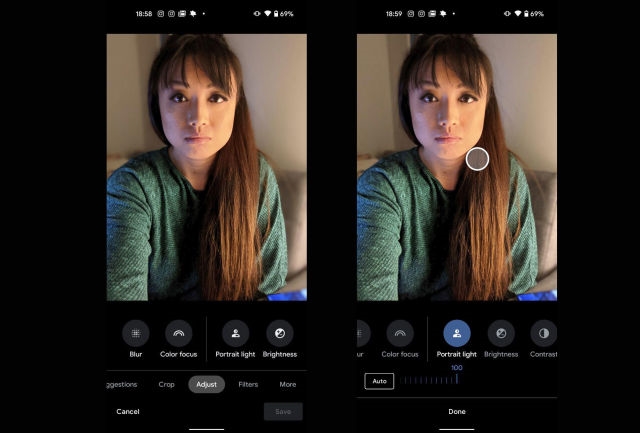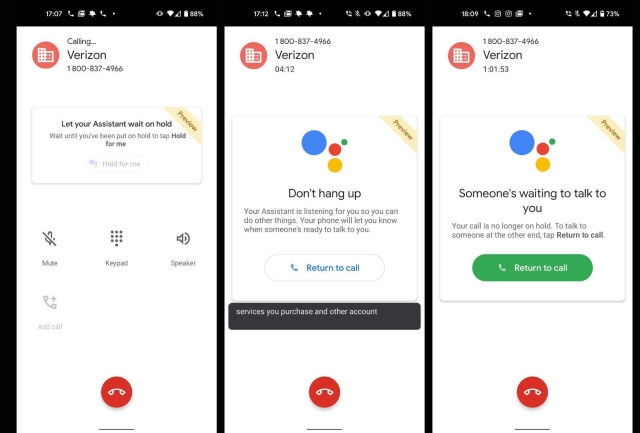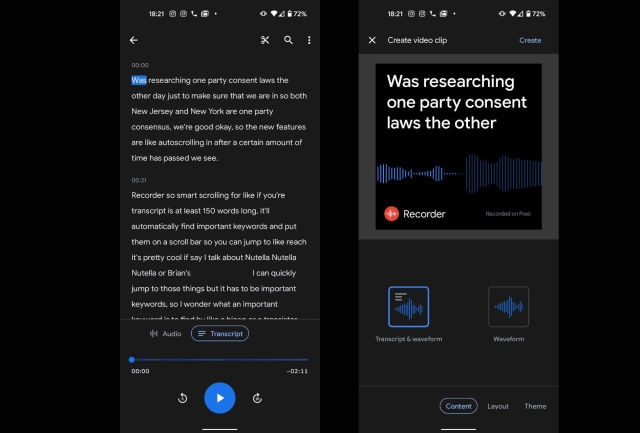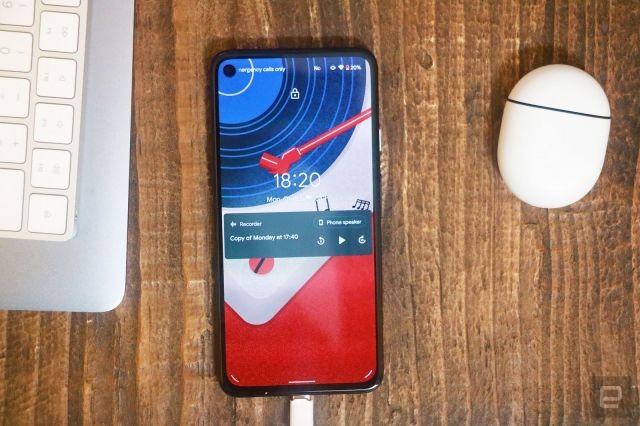Pixel 4a 5G review: Good, but you can do even better
Google is bucking the $1,000 phone trend, and I’m here for it. The company’s Pixel 4a received nearly universal acclaim earlier this year, if only because that $350 price tag was impossible to argue with. But with the new Pixel 4a 5G and Pixel 5, Google’s decision to prioritize affordability and 5G speeds over premium specs was met with criticism. The 4a 5G in particular is basically a slightly stretched-out 4a with a second camera and, well, a 5G radio. For that, you’ll be paying north of $500.
Google’s priorities for 2020 are clear, and though this year’s Pixel lineup is slightly confusing, it represents a reprieve from the exorbitant flagships we’ve seen from Apple and Samsung. But it’s not as if the Pixel 4a 5G doesn’t face competition from OnePlus or Samsung, both of which have solid offerings for about the same price. The question then is: If you buy the Pixel 4a 5G now, will it be good enough to last you the next few years?
![]()
It’s easier to differentiate between the 4a 5G and the Pixel 5: The headphone jack is a dead giveaway that I’ve got the 4a. Also, the Pixel 5 has a shinier and less clicky power button. What’s more, all three phones have a fingerprint sensor on the rear, which I prefer to face recognition when it comes to unlocking my phone.
The camera setups on the two phones are another subtle tell — the 4a 5G has a second lens, which wasn’t included on the original 4a. Technically, you should also be able to tell by the light blue power button that you’re holding the 4a 5G and not the 4a, which has a light green button. But again, without a side-by-side comparison these colors are similar enough that I constantly second-guess myself. The point is, if you like the look of this year’s Pixel phones, you’ll be happy with the 4a 5G. It’s slightly bigger, but not so much that it looks oversized.
Like its siblings, the Pixel 4a 5G features a notchless all-screen design with a small hole cut out in the top left for the selfie camera. Its bezels are ever so slightly thicker than the Pixel 5’s, and about the same size as the 4a’s. I only mention it to highlight the minute disparities between the 4a 5G and 5 for the $200 difference. Oh, and you’ll also be able to get the Pixel 5 in a beautiful new color option: sage green (or, as Google calls it, Sorta Sage). Meanwhile, the 4a and 4a 5G only come in standard black.
Display and audio
The biggest difference between the three Pixels is their screens. The Pixel 5 is the only one to offer a 90hz refresh rate, while the 4a and 4a 5G are stuck on 60hz, which is quickly becoming outdated. That said, in daily use I didn’t notice a huge benefit in having a faster screen. But the contrast was clear when I put the 5 and 4a 5G side by side and rapidly scrolled up and down my Instagram feed. The 5 easily keeps up, while the slower screen stutters.
It’s not as if you’re going to be scrolling in a frenzy all day, so this feels like a reasonable tradeoff for the price. A more meaningful distinction between the 4a 5G and the 5 is the actual size of the screen. For those who need more room for bigger fonts or just prefer a larger display for movies or reading, the 4a 5G’s 6.2-inch panel trumps the Pixel 5’s 6-inch screen. They have the same Full HD+ resolution, so things occasionally look a little fuzzier on the 4a 5G than on the smaller models. Though I noticed this softness in some app icons, the lower pixel density generally didn’t bother me.
One last difference between the two screens: The Pixel 5 supports a contrast ratio of a million to one, while the 4as go up to 100,000 to 1. Despite that, I never found the cheaper phone to be lacking punch and really only saw the difference when I compared them to the Pixel 5. All told, the 4a 5G’s screen was a lovely, vibrant canvas for all the music videos and Netflix shows I streamed to it.
As I expected, the 4a 5G’s stereo speakers provide ample volume but are lacking in bass. I still heard songs like Blackpink’s How You Like That clearly, and most people will be streaming music to speakers or headphones anyway. The speakers were adequate for voice and video calls, which is a more common use case, though you’ll want to be careful not to cover up the bottom-firing speakers.
Cameras
Google’s camera software has been on point for years, but it’s been slow to the dual sensor game. With its latest Pixels the company finally added a second ultrawide lens to the rear, which is much more versatile than the telephoto option on last year’s flagships. The Pixel 4a 5G and the 5 have the same camera setup, so you won’t be missing much if you buy the cheaper phone.
The company said it tweaked its processing algorithms so that people’s faces don’t appear distorted in shots taken with the ultrawide camera. The funny thing is, it’ll fix facial distortion by shifting a person’s head closer to the center of the frame but leave their body untouched. This resulted in a hilarious picture of my colleague Chris Velazco looking disproportionate.
I haven’t yet had the chance to test this in more scenarios, so there might be other factors affecting the result. In my pictures of buildings, though, there is minimal distortion near the edges of the image. I used the Note 20 Ultra’s wide angle camera on the same scene and while Chris and I could barely see a difference, our video producer Brian Oh’s trained eyes spotted some slight distortion in Samsung’s picture compared to Google’s.
Most of the new camera features are in the software, which is where Google tends to shine. The company was the first to launch an effective low light mode when it debuted Night Sight on the Pixel 3 back in 2018. Since then, Google said it’s found the feature so good at improving pictures in dim conditions that it’s doing away with the automatic flash tool altogether. Don’t worry, you’ll still have an LED flash and selfie screen light if you still want that extra illumination in the dark. But you’ll have to manually turn on the flash instead of letting the phone determine when to use it.
Instead, when it thinks there’s not enough light in your shot, the Pixel 4a 5G automatically activates Night Sight. You’ll see the crescent moon symbol on the shutter button, which indicates the mode is on, and you’ll have to hold your phone steady for the few seconds it takes to get the shot. This works in portrait mode as well.
Whether you find this feature useful depends on how much you liked Night Sight in the first place. If you were never into it, you’ll hate that it kicks in by default, but at least you can turn it off. It’s a little annoying if you weren’t expecting it, especially since you’ll need to keep still for a few seconds more to capture a photo in Night Sight. But by and large the pictures came out nicely, and I remain as impressed by Google’s processing software as ever.
Another new software feature is a group of stabilization modes for video recording. You’ll now find options for Standard, Locked, Active and Cinematic pan as opposed to just one standard option in the earlier models. Standard and Active are fairly common, and you might not even notice a significant difference between them. I filmed some cars and pedestrians at a busy intersection and though the footage was decently steady, I didn’t notice a major difference. Locked mode let me frame up a specific area, then kept my subject in the center despite small camera movements due to hand shake. It’s useful for keeping tight focus on a stationary object, but I don’t see myself using it much.
The real showstopper is a new cinematic pan mode. This slows the footage down to half the speed and mutes the audio, shooting at twice the framerate for a much smoother scene that has an almost slow-motion quality. I pointed my phone at autumnal foliage in Prospect Park as my cab drove by, and the resulting 1080p clips were impressively smooth. The fact that they were slowed down also made them easier to watch. My Instagram viewers probably appreciated that the clips were less nausea-inducing.
As much as I like cinematic pan, my favorite new camera feature is actually portrait light since it’s not always easy to get flattering illumination for my selfies. But Google’s latest feature means that I might be able to get good portraits even in suboptimal conditions. You don’t have to do anything to enable this feature; as long as you shoot in Portrait mode with the front camera, you’ll be able to edit the photo afterward, moving a faux light source around. This is fairly similar to what the iPhone and Huawei phones already offer, although they provide a greater variety of spotlight options. Apple’s mode doesn’t give you as much control over where the light shines on your face, though.

I was hopeful that Google’s tool might save pictures taken in tricky lighting, but it wasn’t the miracle I was expecting. This was only designed to offer smaller-scale, targeted tweaks. I took a selfie in a backlit setting with uneven overhead light, and when I edited the photo afterwards, I dragged a circle around to cast some brightness on my face. I only really saw a difference when I dragged the intensity up past 80 percent, and managed to get rid of some shadows on my left cheek.
Speaking of editing pictures, I like how much easier to use the new Photos editor is. Google rolled out this updated editor earlier this month, and it gives you more precise control over settings like Brightness, Contrast, Highlights, Shadows and more. The 4a 5G’s camera app also features some interface changes, and I appreciate that modes like Time Lapse and Slow Motion are no longer buried in the More section. Instead, you’ll find them right above the shutter button when you go to take a video. It’s also easier to share a photo you just took now — you can swipe in from the thumbnail next to the shutter and pick one of four suggested apps.
Software updates
One of my favorite things about Google’s phones over other Android handsets is the Pixel-first software experience. With the Pixel 3, for example, the company introduced helpful AI-assisted tools like Call Screening and Duplex for restaurant reservations. Since then, Pixels have been the first phones to get things like Live Caption, What’s Playing and Night Sight. Sometimes, these features are even exclusive to Google’s hardware.

This year, Google is introducing a Hold For Me service on the Pixel 4a 5G and 5 that lets Assistant stay on the line on your behalf when you’re put on hold. When it’s finally your turn to speak with a person, the Assistant will tell the agent that you’re using the service and that you’ll be right back. It’ll send you an alert that you’ve been connected, and your phone will ring, too, in case you’ve wandered away from your table.
In the short time since I’ve had the Pixel 4a 5G, I thankfully haven’t had real reason to make calls to actual customer service agents, so I’ve tried this once with a Verizon Fios helpline and again with the hotline Google set up for reviews. (I felt bad doing more tests and wasting the time of customer service reps.)
You have to first enable Hold For Me in the phone’s settings, then make your call. Once the line connects, a button appears on the screen so you can get the Assistant to take over and hold for you when you’re ready. After answering a series of questions through Verizon’s automated help system, I was placed on hold. I tapped Assistant in, and a card appeared on the screen telling me not to hang up. It also offered an option to “Return to call” in case I wanted to confirm that I was still on hold, and muted the hold music, which was nice. Google’s Live Caption feature also kicked in to show me what was being said on the call, which was mostly a loop of “Our customer service agents are currently busy, please remain on the line for the next available representative.”
I returned my attention to my work and actually forgot I was still on hold until an hour later, when the 4a 5G rang loudly and told me onscreen that a support agent was ready for me. When I rejoined the call (which took awhile since I had to first mute the music on my smart speaker), the rep on the other end was introducing themself. They told me that the Assistant had told them I was using a Google service and to wait for me to get back.
I appreciate the freedom of being able to play my music while on hold instead of having to listen to whatever is on the line, and not having to be surprised every time a recorded “please remain on the line” message is played. But I didn’t find Hold For Me truly liberating since I still knew in the back of my mind that I needed to be ready to speak with a service representative at any moment. I’d also need to learn to trust Assistant more before I can feel comfortable walking away from my phone while it stays on the line for me.

Another Pixel-exclusive feature I’ve loved is the Recorder app that debuted on the Pixel 4. I’ve used it mostly for interviews as a more-secure alternative to the AI transcription service I’d normally use. With the latest Pixels, Google is rolling out version 2 of the app, which offers useful new features like a keyword-pegged scroll bar, a video generator for your soundbites and audio editing so you can trim out specific clips.
I’m an oversharer, so I love that video tool. You can trim your audio file to the exact length you want, then create a shareable clip. Google will display an animated waveform and you can choose to add the subtitles to it. There are some basic templates, including square, portrait or landscape orientations and light or dark themes.
Not only is this a great format for sharing audio snippets to video-first platforms like YouTube or Instagram, but it’s also a way to be more inclusive, especially of people who are hard of hearing or deaf. I can already see this tool replacing Headliner as my main means of creating quick clips for social media to promote highlights from the Engadget Podcast.
With the Pixel 4a 5G, Google is also adding a new Assistant Snapshot page to the Feed so that when you swipe to the left of your home screen, you’ll see more than just suggested news articles. You can also get your upcoming calendar events, weather reports and commuter info (remember commutes?). I liked the way Microsoft implemented this on the Surface Duo, which pulls in more info like recent checklists from the To Do app, and displays it all on the same page as the articles. Google takes a different approach, hiding your Snapshot in a separate panel that you have to tap a button at the top left of your Feed to access. This could be a useful feature, but I wish the Pixel integrated it better.
Performance and battery life
With its Snapdragon 765G processor and 6GB of RAM, the Pixel 4a 5G ran smoothly in daily use. Granted, I didn’t throw anything too heavy at it — mostly just endless rounds of Solitaire while chatting with my friends and browsing Twitter and articles online. To ramp things up, I also started screen recording my high-speed Solitaire skills while launching the Pokemon Cafe Mix game. Even then, the 4a 5G held up. I did notice a few hiccups when trying to share or edit pictures I had just taken with the camera app, though.
Considering this uses a slower processor than the Pixel 4, the stutter is understandable. And given how smoothly the Pixel 4a ran with a slower Snapdragon 730G, I’m not surprised that Google was able to make its software fly on a non-flagship CPU.
What did surprise me was the 4a 5G’s battery life, which was so long it actually kept me from leaving my house. It ran our video looping test for close to 17 hours and still had 24 percent capacity left. I had to stop the test and head out with just 20 percent on the phone, but I wasn’t worried I’d be left with a dead device. A Google spokesperson told Engadget that it did “intentionally [improve] power efficiency across a range of workloads, and video playback was one of the areas with the biggest gain.” In real-world use, the 4a 5G usually stuck around for a day and change, which is in line with the S20 FE and the OnePlus Nord.

In the event that I was truly concerned about the Pixel 4a 5G giving up on me, I could turn on the new Extreme Battery Saver mode to kill all but a selection of apps. When you first enable the standard Battery Saver tool in the Settings shade, you’ll be shown a prompt to try the extreme version and pick the apps you want to keep running in the pared down mode. Everything else will be paused so you won’t get notifications from them.
Of course, depending on what you choose, the boost you get will vary. System apps like Camera, Clock, Messages and Play Store can’t be disabled. I decided to keep Instagram, WhatsApp and Telegram running in Extreme Battery Saver. I still haven’t spent enough time with the Pixel 4a 5G to get a sense for how much juice I can squeeze out of it, but the idea is promising in theory and I like the flexibility of picking exactly what apps to keep running. And like the Digital Wellbeing timeout feature, you can still choose to unpause an app while in Extreme Battery Saver, which is helpful for when you need to open Maps, Uber or Lyft to get home, for example.
Another feature I’d like to test more thoroughly over time are some of the optimizations Google made for 5G networks. Some, like Fast Mobile Downloads to quickly get your podcasts or playlists when you’re on the high-speed network, are only available on Verizon and AT&T for now. I’m not on either of those carriers, so I couldn’t test it during this time. Google also enhanced Duo HD calling for higher quality calls on 5G, as well as better game streaming on Stadia.
Which Pixel should you get?
If you’ve got your heart set on a Pixel, the most important decision is which of this year’s phones to get. It largely boils down to how much money you’re willing to spend and what features you’re okay sacrificing. Those who want to save the most money, have a great camera and don’t mind missing out on 5G for their next phone should get the 4a. At $350, it’s a steal and worthy of being most people’s daily drivers.
Things get trickier if you have more to spend. First, if you’re on Verizon (heads-up, that’s our parent company!), the 4a 5G will cost you an extra $100 for the pleasure of using the network’s millimeter wave (excuse me, ultra wideband) 5G. The Pixel 5, which costs $100 more than that, supports both sub-6Ghz and mmwave systems, so you might as well get Google’s most expensive phone since it brings water resistance, a faster screen, nicer colors and wireless charging.
The Pixel 4a 5G is best for those who want a bigger screen, a headphone jack and think they probably won’t ever get their phone wet. I’ve used the 4a 5G in a light drizzle to test its camera and it’s survived, but if you frequent pools, lakes or the seaside, the Pixel 5 might be a better option.
If you want a more fun color option or a different design altogether, Samsung’s Galaxy S20 Fan Edition (FE) comes in a plethora of cheerful colors and rocks a minimal style that’s similar in spirit to all the new Pixel phones. It has a larger 6.5-inch screen with a 120Hz refresh rate, more rear cameras, a faster processor and IP68 water resistance. It’s worth nothing, though, that the 5G version starts at $700, which is $200 more than the base 4a 5G.
If you’re in Europe or can find one in the US, the OnePlus Nord also offers a triple camera setup and a 6.44-inch 90hz display for $500. The Nord also comes in a pretty blue variant. Still, those who like Google’s software features and camera prowess will prefer the Pixel family.
Wrap-up
It’s hard to sum up how I feel about the Pixel 4a 5G. It’s basically the larger version of the popular Pixel 4a, which at $350 is the best phone in its price range. With a new wide angle camera on the back and a slightly better processor, the 4a 5G is definitely an upgrade over the 4a. But it’s also $150 to $250 more expensive, and doesn’t seem to bring enough advancements to justify that delta. For that extra money, you’ll mostly be getting the secondary camera and bigger screen, since most of the new camera features should be coming to the 4a anyway.
If you plan to pay for your new Pixel over a year or two, the $200 difference (or $100, if you’re on Verizon) might feel less significant. In which case, spending more on the Pixel 5 might be a better decision, if only for the peace of mind you get with water resistance. The smoother screen will also make the phone feel like it’s faster, and the difference in display size is almost negligible. The main reason to get the 4a 5G is if you absolutely cannot go over $500 and want a more versatile camera than the Pixel 4a, or if you really want a headphone jack on a modern phone. That said, despite the fact that it overlaps in so many ways with its stablemates, the Pixel 4a 5G is still a capable device for the money.
Key specs
|
|
Google Pixel 4a 5G |
|---|---|
|
Processor |
Qualcomm Snapdragon 765G |
|
RAM |
6GB |
|
Internal storage |
128GB |
|
Main Display |
6.2-inch OLED with transmissive hole |
|
Display resolution |
2,340 x 1,080 (19.5:9) |
|
Rear cameras |
12.2MP f/1.7 camera with HDR, optical + digital image stabilization and autofocus with dual pixel phase detection and 16MP f/2.2 ultrawide camera with 107-degree field of view |
|
Front-facing camera |
8MP f/2.0 camera with 83 degree FOV |
|
OS |
Android 11 |
|
Charging |
USB C with USB-PD 2.0, supports 18W fast charging |
|
Battery size |
3,800mAh (min); 3,885mAh (typical) |
|
Dimensions |
6.1 x 2.9 x 0.3 inches |
|
Weight |
168g (sub-6 only) / 171g (mmWave and sub-6) |
|
Fingerprint sensor |
Yes, on rear |
|
Waterproofing |
No |
|
NFC |
Yes |
|
Headphone jack |
Yes |
(16)

